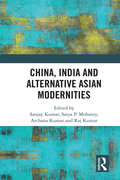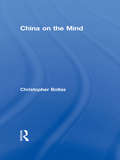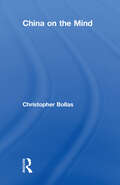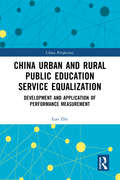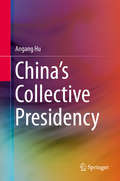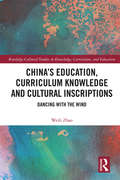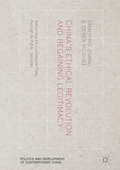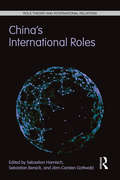- Table View
- List View
China, India and Alternative Asian Modernities
by Kumar Sanjay Satya P. Mohanty Archana Kumar Raj KumarThe conception of modernity as a radical rupture from the past runs parallel to the conception of Europe as the primary locus of global history. The essays in this volume contest the temporal and spatial divisions—between past and present, modernity and tradition, and Europe’s progress and Asia’s stasis—which the conventional narrative of modernity creates. Drawing on early modern Chinese and Indian history and culture instead, the authors of the book explore the provenance of modernity beyond the west to see it in a transcultural and pluralistic light. The central argument of this volume is that modernity does not have a singular core or essence—a causal centre. Its key features need to be disaggregated and new configurations and combinations imagined. By studying the Bhakti movement, Confucian democracy, and the maritime and agrarian economies of China and India, this book enlarges the terms of debate and revisits devalued terms and concepts like tradition, religion, authority, and rural as resources for modernity. This book will be of great interest to researchers and academicians working in the areas of history, Sociology, Cultural Studies, literature, geopolitics, South Asian and East Asian Studies.
China-Japan Relations in the 21st Century: Antagonism Despite Interdependency
by Lam Peng ErThis new collection examines the paradox of Sino-Japanese relations and the rising diplomatic antagonism between both countries despite deepening economic interdependency. Offering a unique perspective on the history of bilateral ties since diplomatic normalization in 1972, it considers the growing interdependency between China and Japan in bilateral trade, investment, tourism and education, as well as the question of nationalism and Sino-Japanese rivalry in multilateral settings such as in ASEAN processes, the Mekong Basin and the South China Sea. Focusing on the power transition in East Asia, the lack of a common enemy in the post-Cold War era, the clash of Chinese and Japanese nationalism, and a lack of trust, shared values and common identity between China and Japan, this collection addresses the origins of a troubled bilateral relationship which could impact on the stability and prosperity of East Asia.
The China Model: Political Meritocracy and the Limits of Democracy
by Daniel A. BellWesterners tend to divide the political world into "good" democracies and “bad” authoritarian regimes. But the Chinese political model does not fit neatly in either category. Over the past three decades, China has evolved a political system that can best be described as “political meritocracy.” The China Model seeks to understand the ideals and the reality of this unique political system. How do the ideals of political meritocracy set the standard for evaluating political progress (and regress) in China? How can China avoid the disadvantages of political meritocracy? And how can political meritocracy best be combined with democracy? Daniel Bell answers these questions and more.Opening with a critique of “one person, one vote” as a way of choosing top leaders, Bell argues that Chinese-style political meritocracy can help to remedy the key flaws of electoral democracy. He discusses the advantages and pitfalls of political meritocracy, distinguishes between different ways of combining meritocracy and democracy, and argues that China has evolved a model of democratic meritocracy that is morally desirable and politically stable. Bell summarizes and evaluates the “China model”—meritocracy at the top, experimentation in the middle, and democracy at the bottom—and its implications for the rest of the world.A timely and original book that will stir up interest and debate, The China Model looks at a political system that not only has had a long history in China, but could prove to be the most important political development of the twenty-first century.
The China Model: Political Meritocracy and the Limits of Democracy
by Daniel A. BellWesterners tend to divide the political world into "good" democracies and “bad” authoritarian regimes. But the Chinese political model does not fit neatly in either category. Over the past three decades, China has evolved a political system that can best be described as “political meritocracy.” The China Model seeks to understand the ideals and the reality of this unique political system. How do the ideals of political meritocracy set the standard for evaluating political progress (and regress) in China? How can China avoid the disadvantages of political meritocracy? And how can political meritocracy best be combined with democracy? Daniel Bell answers these questions and more.Opening with a critique of “one person, one vote” as a way of choosing top leaders, Bell argues that Chinese-style political meritocracy can help to remedy the key flaws of electoral democracy. He discusses the advantages and pitfalls of political meritocracy, distinguishes between different ways of combining meritocracy and democracy, and argues that China has evolved a model of democratic meritocracy that is morally desirable and politically stable. Bell summarizes and evaluates the “China model”—meritocracy at the top, experimentation in the middle, and democracy at the bottom—and its implications for the rest of the world.A timely and original book that will stir up interest and debate, The China Model looks at a political system that not only has had a long history in China, but could prove to be the most important political development of the twenty-first century.
China on the Mind
by Christopher BollasSeveral thousand years ago Indo-European culture diverged into two ways of thinking; one went West, the other East. Tracing their differences, Christopher Bollas examines how these mentalities are now converging once again, notably in the practice of psychoanalysis. Creating a freely associated comparison between western psychoanalysts and eastern philosophers, Bollas demonstrates how the Eastern use of poetry evolved as a collective way to house the individual self. On one hand he links this tradition to the psychoanalytic praxes of Winnicott and Khan, which he relates to Daoism in their privileging of solitude and non verbal forms of communicating. On the other, Bollas examines how Jung, Bion and Rosenfeld, assimilate the Confucian ethic that sees the individual and group mind as a collective, while Freudian psychoanalysis he argues has provided an unconscious meeting place of both viewpoints. Bollas’s intriguing book will be of interest to psychotherapists, psychoanalysts, Orientalists, and those concerned with cultural studies.
China on the Mind
by Christopher BollasSeveral thousand years ago Indo-European culture diverged into two ways of thinking; one went West, the other East. Tracing their differences, Christopher Bollas examines how these mentalities are now converging once again, notably in the practice of psychoanalysis. Creating a freely associated comparison between western psychoanalysts and eastern philosophers, Bollas demonstrates how the Eastern use of poetry evolved as a collective way to house the individual self. On one hand he links this tradition to the psychoanalytic praxes of Winnicott and Khan, which he relates to Daoism in their privileging of solitude and non verbal forms of communicating. On the other, Bollas examines how Jung, Bion and Rosenfeld, assimilate the Confucian ethic that sees the individual and group mind as a collective, while Freudian psychoanalysis he argues has provided an unconscious meeting place of both viewpoints. Bollas’s intriguing book will be of interest to psychotherapists, psychoanalysts, Orientalists, and those concerned with cultural studies.
The China Path and its Original Meaning
by Han QingxiangThis book examines the fundamental issues of Marxism in the 21st century and explores its contributions through the explanatory framework of the unity of continuity and stages, spatial and temporal analysis, and the dialectical relationship of universality and particularity of Marxist historical development. Marxism in the 21st century is a concept closely related to the historical changes of capitalism and the historical shift of the centre of the socialist movement. Marxism in the 21st century should be developed on the basis of the continuation of the fundamental position, value orientation, ideals and beliefs, basic principles and methodological principles of Marxism. This book explores the logic of the development of modernisation in contemporary China and the world, the communication and interaction between contemporary China and the world, and the coexistence of socialism and capitalism. It also examines the relationship between the adaptation of Marxism to the Chinese context, Marxism in contemporary China and in the 21st century. The book also discusses Xi Jinping's Thought on Socialism with Chinese Characteristics for a New Era, which provides a scientific theoretical system for interpreting the contemporary world and could become the core theoretical form of Marxism in the 21st century. The book will be essential reading for students and scholars of Marxism, Chinese studies and modernisation theory.
The China Path and its Original Meaning
by Han QingxiangThis book examines the fundamental issues of Marxism in the 21st century and explores its contributions through the explanatory framework of the unity of continuity and stages, spatial and temporal analysis, and the dialectical relationship of universality and particularity of Marxist historical development. Marxism in the 21st century is a concept closely related to the historical changes of capitalism and the historical shift of the centre of the socialist movement. Marxism in the 21st century should be developed on the basis of the continuation of the fundamental position, value orientation, ideals and beliefs, basic principles and methodological principles of Marxism. This book explores the logic of the development of modernisation in contemporary China and the world, the communication and interaction between contemporary China and the world, and the coexistence of socialism and capitalism. It also examines the relationship between the adaptation of Marxism to the Chinese context, Marxism in contemporary China and in the 21st century. The book also discusses Xi Jinping's Thought on Socialism with Chinese Characteristics for a New Era, which provides a scientific theoretical system for interpreting the contemporary world and could become the core theoretical form of Marxism in the 21st century. The book will be essential reading for students and scholars of Marxism, Chinese studies and modernisation theory.
China Urban and Rural Public Education Service Equalization: Development and Application of Performance Measurement (China Perspectives)
by Luo ZheCentering on issues of disparity and equality in basic public education services in China, this book proposes a performance measurement system that assesses and guides equality of basic public education in urban and rural areas. The author moves beyond traditional research approaches by drawing on methods of public management and mathematics. Pivoted on an improved balanced scorecard model, a complete set of indicators and measuring tools are constructed, whereby the process of education equality can be more effectively measured, managed, and steered. Grounded in empirical studies on public education in the country's Sichuan Province, the book advances suggestions on better policies and optimizing implementation for the purpose of attaining equitable public education services in urban and rural areas. Finally, the study envisages further research directions and possible applications of the performance appraisal model. The title will be of value to scholars and students of education studies, especially those interested in public education, educational equity, and Chinese public education services.
China Urban and Rural Public Education Service Equalization: Development and Application of Performance Measurement (China Perspectives)
by Luo ZheCentering on issues of disparity and equality in basic public education services in China, this book proposes a performance measurement system that assesses and guides equality of basic public education in urban and rural areas. The author moves beyond traditional research approaches by drawing on methods of public management and mathematics. Pivoted on an improved balanced scorecard model, a complete set of indicators and measuring tools are constructed, whereby the process of education equality can be more effectively measured, managed, and steered. Grounded in empirical studies on public education in the country's Sichuan Province, the book advances suggestions on better policies and optimizing implementation for the purpose of attaining equitable public education services in urban and rural areas. Finally, the study envisages further research directions and possible applications of the performance appraisal model. The title will be of value to scholars and students of education studies, especially those interested in public education, educational equity, and Chinese public education services.
China's Bloody Century: Genocide and Mass Murder Since 1900
by R. J. RummelExcept for Soviet citizens, no people in this century have endured so much mass killing as have the Chinese. They have been murdered by rebels conniving with their own rulers, and then, after the defeat in war of the imperial dynasty, by soldiers of other lands. They have been killed by warlords who ruled one part of China or another. They have been executed by Nationalists or Communists because they had the wrong beliefs or attitudes or were simply in the wrong place at the wrong time. In China's Bloody Century, R.J. Rummel's careful estimate of the total number of killings exceeds 5 million.How do we explain such killings, crossing ideological bounds and political conditions? According to Rummel, the one constant factor in all the Chinese mass murder, as it was in the Soviet Union and Nazi Germany, is arbitrary power. It was the factor that united warlords, Nationalists, Communists, and foreign armies. The author argues that whenever such undisciplined power is centralized and unchecked, the possibility exists that it will be used at the whim of dictators to kill for their own ends, whether the aim is ethnic-racial purity, national unity, development, or utopia.The book presents successive periods in modern Chinese history, with each chapter divided into three parts. Rummel first relates the history of the period within which the nature and the amount of killings are presented. He then provides a detailed statistical table giving the basic estimates with their sources and qualifications. The final part offers an appendix that explains and elaborates the statistical computations and estimates.While estimates are available in the literature on the number of Chinese killed in Communist land reform, or in Tibet, or by the Nationalists in one military campaign or another, until this book no one has tried to systematically accumulate, organize, add up, and analyze these diverse killings for all of China's governments in this century. For
China's Bloody Century: Genocide and Mass Murder Since 1900
by R. J. RummelExcept for Soviet citizens, no people in this century have endured so much mass killing as have the Chinese. They have been murdered by rebels conniving with their own rulers, and then, after the defeat in war of the imperial dynasty, by soldiers of other lands. They have been killed by warlords who ruled one part of China or another. They have been executed by Nationalists or Communists because they had the wrong beliefs or attitudes or were simply in the wrong place at the wrong time. In China's Bloody Century, R.J. Rummel's careful estimate of the total number of killings exceeds 5 million.How do we explain such killings, crossing ideological bounds and political conditions? According to Rummel, the one constant factor in all the Chinese mass murder, as it was in the Soviet Union and Nazi Germany, is arbitrary power. It was the factor that united warlords, Nationalists, Communists, and foreign armies. The author argues that whenever such undisciplined power is centralized and unchecked, the possibility exists that it will be used at the whim of dictators to kill for their own ends, whether the aim is ethnic-racial purity, national unity, development, or utopia.The book presents successive periods in modern Chinese history, with each chapter divided into three parts. Rummel first relates the history of the period within which the nature and the amount of killings are presented. He then provides a detailed statistical table giving the basic estimates with their sources and qualifications. The final part offers an appendix that explains and elaborates the statistical computations and estimates.While estimates are available in the literature on the number of Chinese killed in Communist land reform, or in Tibet, or by the Nationalists in one military campaign or another, until this book no one has tried to systematically accumulate, organize, add up, and analyze these diverse killings for all of China's governments in this century. For
China’s Collective Presidency
by Angang HuThis book examines the historical development of China's collective presidency and identifies five key mechanisms which effectively reduce the asymmetries of knowledge and power. The mechanisms discussed are: group or collective succession, collective division of responsibilities and cooperation, collective learning, collective research and collective decision making. This work presents many facts including historical details showing that the collective presidency of China is a unique and prodigious innovation of the Communist Party of China (CPC) and China's socialist political system. We see how China’s political system stands in contrast to the presidential system that exists in the United States, which can be described as a system of personal responsibility of the president. The author identifies characteristics of the collective presidency and introduces a framework for analysis. Chapters then explore the phases of historical development in detail and examine fundamental features in terms of their historical development, operational characteristics and evaluation. The final chapter summarizes the political advantages of collective presidency, particularly international competitive advantages and readers will discover that the route to success for modern China lies in collective presidency. This book will appeal to anyone who wishes to discover how China’s political system works, to explore its political institutions that operate in conjunction with the CPC and the Chinese state or to discover how a collective presidency can work successfully.
China’s Conquest of Taiwan in the Seventeenth Century: Victory at Full Moon
by Young-Tsu WongThis is the first book to comprehensively cover the historical process leading to Taiwan’s integration with Mainland China in the seventeenth century. As such, it addresses the Taiwan question in the seventeenth century, presenting for the first time the process leading to the island’s integration with the mainland through the story of the Zheng family and Admiral Shi Lang. The author has confirmed Zheng Chenggong (Koxinga)’s Ming loyalism and his politicization of the conflicts on the China coast. Thus, the author concludes that Zheng was a “revolutionary traditionalist” who transformed sheer violence into a political movement in an unprecedented way. He politicized the entire region and paved the way for the inevitable conflict with Mainland China. After repeated political talks had failed, the rising Qing China decided to take Taiwan by force. Though seaborne warfare was a formidable task at the time, the man who overcame these difficulties and completed the seemingly impossible mission was none other than Admiral Shi Lang. The book provides a new and more justifiable assessment of the Admiral’s contribution to the conquest of Taiwan and pacification of coastal unrest. The book will be of interest to general readers as well as specialists researching security and warfare on the China coast.
China’s Democracy Path (China Insights)
by Ning FangThis book argues that democracy is the inevitable product of China's industrialization and modernization, and is necessary for the development of China's current society. It provides a political guarantee for China's industrialization and modernization. There are both similarities and differences between China's version of democracy and those versions of other countries. In this book, the author discusses the country's important experiences in constructing democracy with Chinese characteristics, which it has gathered during the long struggle for national independence, prosperity and social development. The democracy system embodies basic values and universal principles of democracy with uniquely Chinese characteristics.
China’s Education, Curriculum Knowledge and Cultural Inscriptions: Dancing with The Wind (Routledge Cultural Studies in Knowledge, Curriculum, and Education)
by Weili ZhaoWith a focus on the role of discourse and language in education, this book examines China’s educational reform from an original perspective that avoids mapping on Westernized educational sensibilities to a Chinese environment. Zhao untangles the tradition-modernity division expressed in China’s educational language about the body and teacher-student difference. Exploring the historical and cultural implications of the ways China’s schooling is talked about and acted upon, Zhao argues that Chinese notion "wind" (feng) is a defining aspect of Chinese teaching and learning. Incorporating Western and Chinese literature, this book explores the language of education, curriculum, and knowledge on a cross-cultural landscape and as cultural inscriptions.
China’s Education, Curriculum Knowledge and Cultural Inscriptions: Dancing with The Wind (Routledge Cultural Studies in Knowledge, Curriculum, and Education)
by Weili ZhaoWith a focus on the role of discourse and language in education, this book examines China’s educational reform from an original perspective that avoids mapping on Westernized educational sensibilities to a Chinese environment. Zhao untangles the tradition-modernity division expressed in China’s educational language about the body and teacher-student difference. Exploring the historical and cultural implications of the ways China’s schooling is talked about and acted upon, Zhao argues that Chinese notion "wind" (feng) is a defining aspect of Chinese teaching and learning. Incorporating Western and Chinese literature, this book explores the language of education, curriculum, and knowledge on a cross-cultural landscape and as cultural inscriptions.
China’s Ethical Revolution and Regaining Legitimacy: Reforming the Communist Party through Its Public Servants
by Shaoying Zhang Derek McgheeThis book examines the many ways in which the Communist Party in China is still revolutionary by focusing on how, in recent years, it has attempted to mobilize Party members to become ethical subjects. In the context of the Party’s history of the military revolution, Cultural Revolution and Economic Reform (or economic revolution), the authors argue that under President Xi Jinping the Party has launched an ethical revolution within the Party for the sake of sustaining its legitimacy. This book examines the various combined components of this ethical revolution, including anti-corruption, anti-four undesirable working styles and Mass-Line Education programme from the perspective of the fifty current Communist Party officials.
China’s Ethical Revolution and Regaining Legitimacy: Reforming the Communist Party through Its Public Servants
by Shaoying Zhang Derek McgheeThis book examines the many ways in which the Communist Party in China is still revolutionary by focusing on how, in recent years, it has attempted to mobilize Party members to become ethical subjects. In the context of the Party’s history of the military revolution, Cultural Revolution and Economic Reform (or economic revolution), the authors argue that under President Xi Jinping the Party has launched an ethical revolution within the Party for the sake of sustaining its legitimacy. This book examines the various combined components of this ethical revolution, including anti-corruption, anti-four undesirable working styles and Mass-Line Education programme from the perspective of the fifty current Communist Party officials.
China’s Foreign Aid and Investment Diplomacy, Volume I: Nature, Scope, and Origins
by John F. CopperToday, by many accounts, China is the world's foremost purveyor of foreign aid and foreign investment to developing countries. This is the product of China's miracle economic growth over a period of more than three decades, together with China's drive to become a major player in world affairs and accomplish this through economic rather than military means. This three-volume work is the first comprehensive study of China's aid and investment strategy to trace how it has evolved since Beijing launched its foreign aid diplomacy at the time of the founding of the People's Republic of China in 1949.Volume I examines the definitions, origins, nature, and scope of foreign aid and investment by other countries. Using that background, John F. Copper then traces China's financial assistance to developing countries from the Mao period - when China gave meaningful foreign aid despite its own economic struggles - through the beginning of China's post-1978 economic boom and during subsequent decades of rapid economic growth. Copper shows that China has a more salient history in giving foreign assistance than any other country in the world; while China's objectives in giving foreign assistance have changed markedly over time, China has always been driven by efforts to realize its foreign policy objectives and expand China's external influence.
China's Governance: Across Vertical and Horizontal Connexions (SpringerBriefs in Political Science)
by Peijie WangThis book elucidates fundamental governance features and issues in contemporary China. While especially focusing on principal governance areas, it offers comprehensive coverage, capturing the dynamics of governance across vertical and horizontal connexions. The book is succinctly written and systematically addresses essential governance aspects that to date have only been dealt with separately and sporadically: state governance, the executive branch and administration, organization of production and approaches to production, and governance conventions and protocols. Further, it examines the evolution of governance practice in terms of both political and legal superstructure and economic base/infrastructure. Adopting a purely analytical approach and making no value judgments on the country’s social institutions and political systems, the book offers a vital resource to help readers grasp the complexities of governance in China.
China’s Hong Kong: A Political and Cultural Perspective (China Academic Library)
by Shigong JiangThis book differs from most others of its kind, by looking at the Hong Kong issue from China’s perspective, which in turn mirrors China’s own situation. Through a legal lens, the author conducts a political and cultural examination of the past and the present, and provides a comprehensive overview of the many theories and problems concerning Hong Kong. Including reflections on the theory of administrative absorption of politics, a historical review of “one country, two systems” and an analysis of the form and nature of the Basic Law, it offers a valuable reference resource for studying the historical, political and legal context of Hong Kong under the principle of “one country, two systems”. Instead of over-simplifying the issue of Hong Kong or only seeing it as a Chinese regional issue, the book regards it as a central Chinese issue and the key to understanding China.
China’s Inevitable Revolution: Rethinking America’s Loss to the Communists
by T. LutzeThis book examines the political exigencies facing both the US and the Chinese Communist Party during the decisive years of the Chinese Civil War. The book offers a new and challenging perspective on America's infamous loss in China, and on the Communists' victory.
China's International Roles: Challenging or Supporting International Order? (Role Theory and International Relations)
by Sebastian Harnisch Sebastian Bersick Jö-Carsten GottwaldThis collection examines changes in China’s international role over the past century. Tracing the links between domestic and external expectations in the PRC’s role conception and preferred engagement patterns in world politics, the work provides a systematic account of changes in China’s role and the mechanisms of role taking. Individual chapters address the impact of China’s history and identity on its bilateral role taking patterns with the United States, Japan, Africa, the Europe Union, and Socialist States as well as China’s role in international institutions, the G-20, and East Asia’s Financial Order. Each of the empirical chapters is written to a common template exploring the role of historical self-identification, altercasting and domestic role contestation in shaping the PRC’s role. The volume provides an analytically coherent framework evaluating whether cooperation or conflict in China’s international engagement is likely to increase, and if so, the extent to which this will follow from incompatible domestic demands and external expectations. By combining a theoretical framework with strong comparative case studies, this volume contributes to the ongoing debate on China’s rise and integration into the international society and provides sound conclusions about the prospects for a transition of China’s purpose in world politics.
China's International Roles: Challenging or Supporting International Order? (Role Theory and International Relations)
by Sebastian Harnisch, Sebastian Bersick and Jörn-Carsten GottwaldThis collection examines changes in China’s international role over the past century. Tracing the links between domestic and external expectations in the PRC’s role conception and preferred engagement patterns in world politics, the work provides a systematic account of changes in China’s role and the mechanisms of role taking. Individual chapters address the impact of China’s history and identity on its bilateral role taking patterns with the United States, Japan, Africa, the Europe Union, and Socialist States as well as China’s role in international institutions, the G-20, and East Asia’s Financial Order. Each of the empirical chapters is written to a common template exploring the role of historical self-identification, altercasting and domestic role contestation in shaping the PRC’s role. The volume provides an analytically coherent framework evaluating whether cooperation or conflict in China’s international engagement is likely to increase, and if so, the extent to which this will follow from incompatible domestic demands and external expectations. By combining a theoretical framework with strong comparative case studies, this volume contributes to the ongoing debate on China’s rise and integration into the international society and provides sound conclusions about the prospects for a transition of China’s purpose in world politics.
